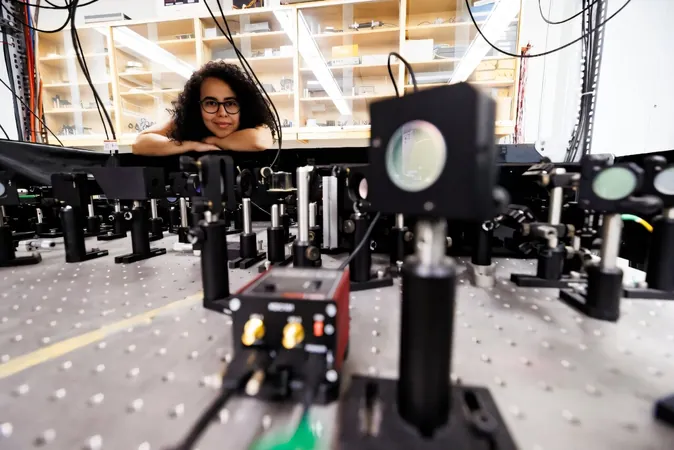
Scientists Unravel the Mysteries of 'Negative Time' in Groundbreaking Quantum Experiments
2024-12-21
Author: Lok
In a stunning revelation that challenges preconceived notions of temporal mechanics, researchers from the University of Toronto have made headlines by demonstrating the existence of "negative time" in quantum experiments. While light has previously shown signs of exiting materials before entering them—a phenomenon often dismissed as mere visual distortion—this team's findings suggest there’s more to the story than meets the eye.
These findings, currently available on the preprint server arXiv, have already stirred debates among scientists and attracted global attention. The researchers clarify that their work is not proposing a radical rethinking of time but rather shedding light on the quirks inherent in quantum mechanics.
Professor Aephraim Steinberg, a leading figure in this research, noted, “This is tough stuff, even for us to talk about with other physicists. We get misunderstood all the time.” The intriguing term "negative time" might raise eyebrows, but Steinberg hopes it ignites deeper philosophical discussions surrounding quantum physics.
Laser Experiments Revealing Quantum Quirks
Years of meticulous experimentation paved the way for this breakthrough. The research team, headed by Daniela Angulo, investigated the interactions between photons (light particles) and atoms. When photons interact with these atoms, a fraction is absorbed and subsequently re-emitted, temporarily elevating the atoms into an excited state. The perplexing twist? The duration for which these atoms remained in their excited state was reported as “negative”—an interpretation that elicits strong curiosity and confusion.
Steinberg presented a fascinating analogy: Imagine monitoring the passage of cars through a tunnel. If the entry time for a batch of cars appears to average at noon, some could hypothetically exit prior to that—say, at 11:59 AM. Previously, such instances were disregarded as anomalies. Angulo and her colleagues provided a more unconventional perspective by suggesting that measuring conditions in the tunnel after some vehicles had exited might produce results that appear to be negative, akin to recording an unusual minus sign.
A Sophisticated Setup
The experiments unfolded in a labyrinthine laboratory filled with precisely calibrated lasers and intricate devices over two years. The researchers emphasized that their observations do not suggest time travel is feasible. “We don't want to say anything traveled backward in time,” Steinberg clarified, aiming to correct potential misinterpretations of their work. The phenomenon can be attributed to the probabilistic nature of quantum mechanics, where particles manifest behavior that defies conventional understanding.
Essentials like Einstein's theory of relativity remain untouched, with no paradoxes of time travel or faster-than-light communication posed by their findings. The photons in question did not convey any information, thereby adhering to cosmic regulations.
Mixed Receptions from the Scientific Community
The concept of "negative time" has ignited intellectual fireworks, eliciting admiration as well as skepticism from notable figures in the physics field. Reputed physicist Sabine Hossenfelder vocalized her doubts in a widely viewed YouTube critique, arguing that this form of "negative time" doesn’t relate to actual temporal flow but is rather a description of photon behavior in a medium.
Despite the critiques, Angulo and Steinberg defend their findings as significant steps towards bridging gaps in understanding light's inconsistencies as it travels. Steinberg admitted, however, that while the provocative nature of their title has caused some divisions, no serious challenges have been thrown at their experimental results.
Looking forward, the team acknowledges the exploratory escapade their findings represent, though they are cautious about overhyping potential applications. “I’ll be honest, I don’t currently have a path from what we’ve been looking at toward applications,” Steinberg concluded, indicating the spirit of inquiry that drives scientific endeavors.
In a world increasingly captivated by the duality of science and fiction, the quest to understand time—whether positive, negative, or somewhere in between—continues to captivate thinkers and dreamers alike. This groundbreaking study may very well be the first step toward unraveling the deeper mysteries lurking in the quantum realm.

 Brasil (PT)
Brasil (PT)
 Canada (EN)
Canada (EN)
 Chile (ES)
Chile (ES)
 España (ES)
España (ES)
 France (FR)
France (FR)
 Hong Kong (EN)
Hong Kong (EN)
 Italia (IT)
Italia (IT)
 日本 (JA)
日本 (JA)
 Magyarország (HU)
Magyarország (HU)
 Norge (NO)
Norge (NO)
 Polska (PL)
Polska (PL)
 Schweiz (DE)
Schweiz (DE)
 Singapore (EN)
Singapore (EN)
 Sverige (SV)
Sverige (SV)
 Suomi (FI)
Suomi (FI)
 Türkiye (TR)
Türkiye (TR)